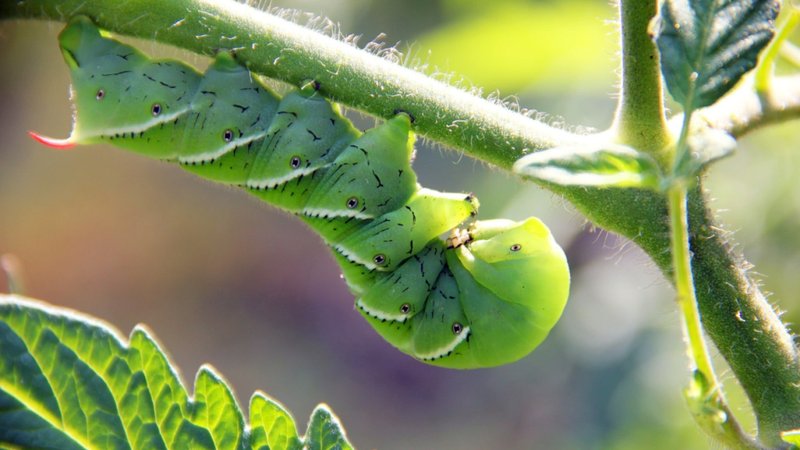
Hornworms are the larval stage of hawk moths and can grow quite large. Seeing one might strike fear into the heart of any gardener—especially when you realize just how much damage they can do in no time flat. The good news is that by understanding their behavior and implementing some strategic measures, you can enjoy a successful growing season without any unwanted hornworm drama.
What Are Hornworms?
Hornworms are caterpillars that belong to the family Sphingidae. They’re particularly fond of tomato, pepper, and eggplant plants, making them a gardener’s worst nightmare. These caterpillars can grow up to 4 inches long, and their green color helps them blend seamlessly into the foliage. You might be wondering how these little guys can cause so much trouble.
Honestly, a single hornworm can devour a significant portion of a plant in just a few days. They not only eat the leaves but can also damage stems and fruits, leaving your crops looking ragged and unproductive. This is especially concerning for those growing in raised beds, where plants are more concentrated. If you don’t catch them early, you could lose your hard work in the blink of an eye!
Signs of Hornworm Infestation
Detecting a hornworm infestation early is crucial for protecting your garden. These caterpillars can be tricky to spot due to their camouflage, but there are some telltale signs to look for.
– Chewed Leaves: If you notice large, irregular holes in your plants’ leaves, that’s a red flag. Hornworms tend to eat the foliage in a very specific way, leaving behind a garden that looks like it has been hit by a tornado.
– Droppings: Keep an eye out for dark green or black droppings on the ground or on the leaves. These little pellets are not just unsightly; they indicate that you’ve got hornworms feasting nearby.
– Silk Webbing: If you see silk webbing or the presence of larvae, it’s a sure sign that hornworms are in the vicinity.
By monitoring these signs closely, you can take action before a small problem spirals into a full-fledged infestation.
Preventive Measures for Hornworms
Now that we know what hornworms are and the signs of their presence, let’s discuss how to keep them away from your raised beds. Here are some practical steps to help you safeguard your garden:
- Crop Rotation: Changing your plant placements each season can confuse pests, making it harder for hornworms to find their favorite food sources.
- Companion Planting: Some plants can naturally repel hornworms. Planting basil or marigolds alongside your crops might help deter these pests.
- Regular Inspections: Take time to inspect your plants weekly. Check the underside of leaves, where hornworms love to hide.
- Beneficial Insects: Certain insects, like parasitic wasps, love to feast on hornworm eggs. Encouraging these friendly bugs in your garden can help keep hornworm numbers down.
Implementing these strategies will set a solid foundation for your garden’s success.
Organic and Natural Solutions
If you do find yourself dealing with hornworms, don’t fret! There are several organic solutions that can help control them without resorting to harsh chemicals. Here are a few options:
– Handpicking: Yes, it might sound unappealing, but picking them off by hand can be effective. Wear gloves if you’re squeamish, and drop them into a bucket of soapy water to eliminate them.
– Neem Oil: Using neem oil spray can disrupt the hornworm’s life cycle and deter further infestations. Make sure to apply it in the evening to avoid harming beneficial insects.
– Diatomaceous Earth: Sprinkling diatomaceous earth around the base of your plants creates a barrier that hornworms can’t cross. It’s harmless to plants and pets but deadly for bugs.
These methods can help you tackle hornworms without compromising the health of your garden or the environment.
The Importance of Healthy Soil
In raised bed gardening, soil health is everything. Having nutrient-rich soil goes a long way in not only growing healthy plants but also in building resilience against pests like hornworms. Here’s how to ensure your soil is the best it can be:
– Add Organic Matter: Incorporate compost, well-rotted manure, or worm castings into your soil. This enriches the soil and helps grow stronger, healthier plants.
– Soil Testing: Consider testing your soil to know what nutrients might be lacking. Adjust your soil pH and nutrient levels as necessary to create an ideal growing environment.
– Mulching: Applying a layer of mulch not only conserves moisture but also can deter pests from accessing your plants.
Healthy soil isn’t just an advantage—it’s a foundation for your entire garden’s success.
Using Physical Barriers
Sometimes, a little physical barrier can go a long way in keeping hornworms at bay. Here are some ideas to consider:
– Row Covers: Lightweight fabric row covers can shield your plants from hornworms while still allowing in sunlight and moisture. Just remove them when the plants flower so that pollinators can do their job.
– Fencing: While it may not stop hornworms, fencing can keep out larger pests and animals that might contribute to plant stress.
– Netting: Using floating row covers can protect smaller plants until they grow large enough to withstand a bit of nibbling.
Physical barriers are like your garden’s armor, providing protection without harming the environment.
Dealing with hornworms in raised beds can be a hassle, but it’s not insurmountable. By staying proactive—monitoring your plants, employing preventive measures, and maintaining healthy soil—you can keep your garden thriving and productive. Remember, it’s all about creating a balanced ecosystem that encourages beneficial insects while deterring pests like hornworms.
With a little care and attention, your raised beds can remain a sanctuary for your plants, allowing you to enjoy the fruits of your labor throughout the season. Happy gardening!

